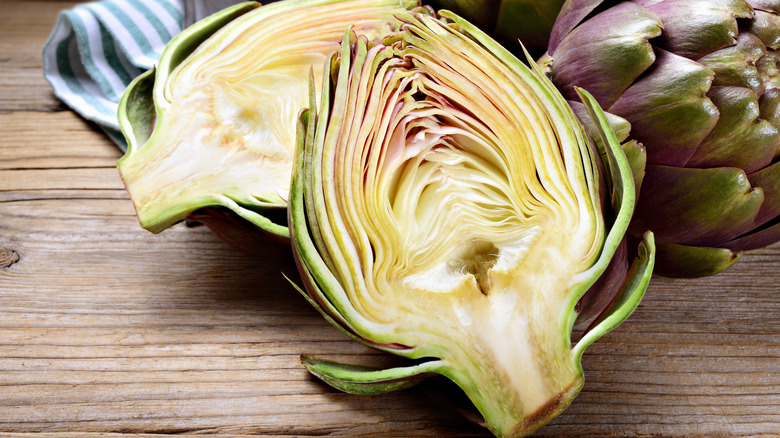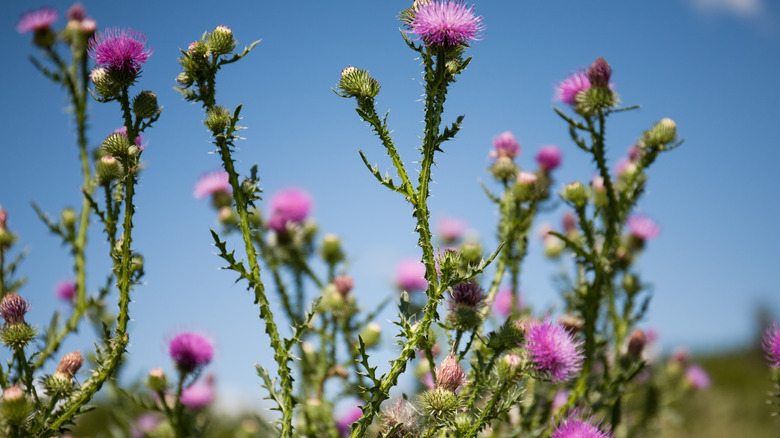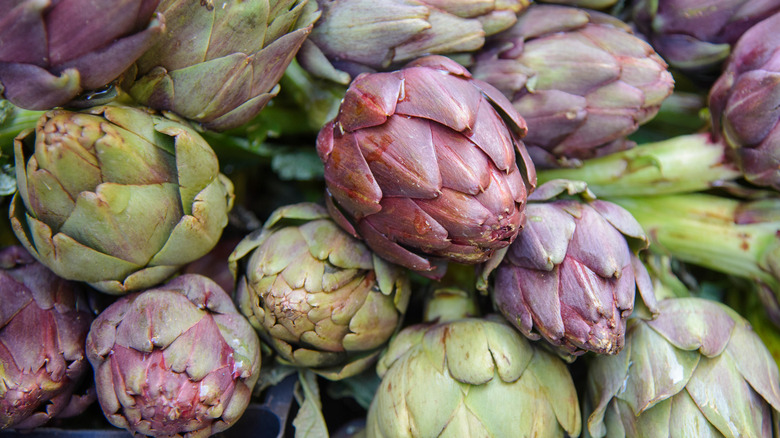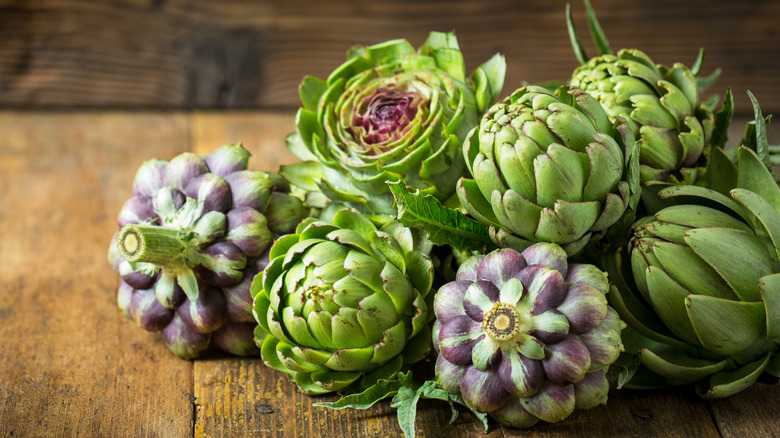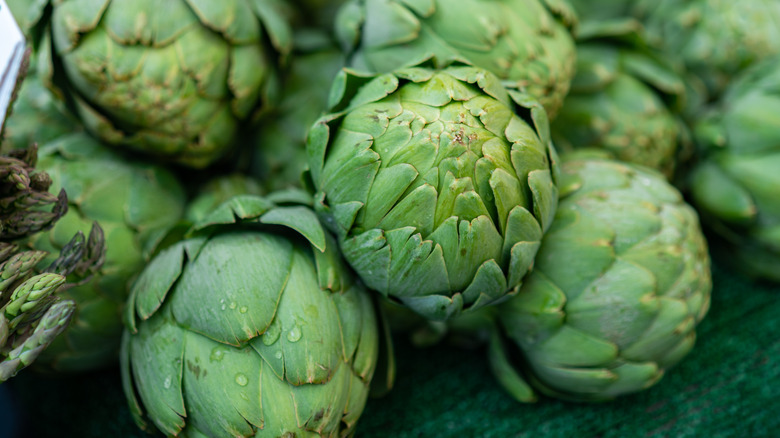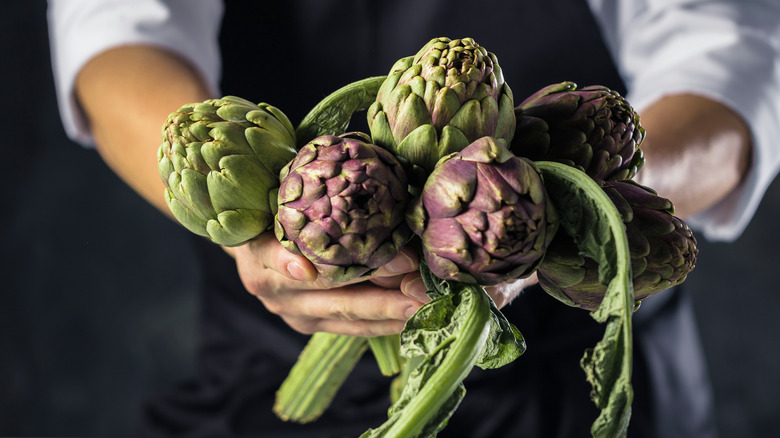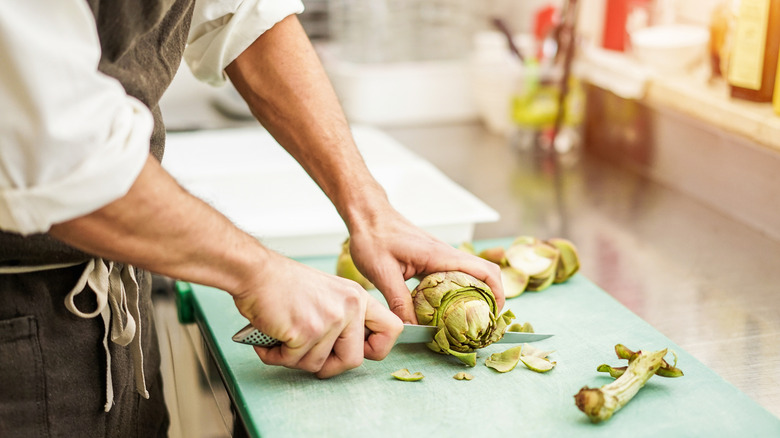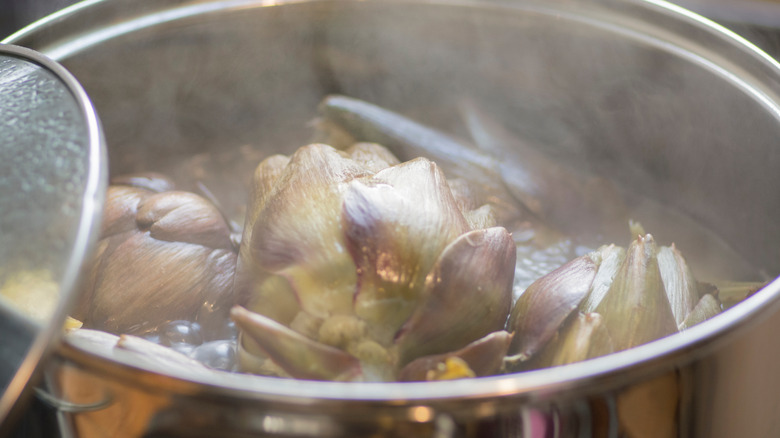Everything You Need To Know About Artichokes
Greek mythology (and NPR) tells us we owe the existence of artichokes to Zeus, who transformed his lover Cynara into the spiky green vegetable after she betrayed him. No wonder it's so difficult to get to their heart! This was the green vegetable's earthly debut, and its scientific name — Cynara scolymus — honors that very story.
Regardless of the veracity of this tale, the vegetable is anything but ordinary. Despite their intimidating, pointy leaves and the multi-step process it takes to eat them, artichokes have been regarded as a delicacy all over the world for centuries. According to NPR, it's believed the vegetable was first cultivated in North Africa as early as 800 AD and later became a staple across the Mediterranean after settlers brought it to Italy.
Eventually, it made its way to the Americas via the help of French settlers in Louisiana during the 19th century, where Spanish immigrants brought it to California for further cultivation. The perfectly mild climate in the Monterey bay area turned out to be ideal for growing conditions; the West Coast state has produced nearly all of the country's artichokes since the 1920s. It's even home to the self-proclaimed "artichoke capital of the world," Castroville, a city that once famously crowned Marilyn Monroe the as their first "Artichoke Queen" back in 1947 (via California Sunday). How many other vegetables have those kind of Hollywood connections?
To this day, artichokes are still popular, with Global Trade estimating that more than 1.9 million tons of the vegetable will be consumed worldwide by 2030.
What is an artichoke?
Though we think of artichokes as just another vegetable, they're actually the edible flower bud of the thistle plant. This makes them a member of the aster family, which includes flowering plants like daisies, sunflowers, and chrysanthemums (via Calyx Flowers). When these buds aren't harvested for our consuming pleasure, the plants can grow as tall as four feet and wide as six feet, sprouting pointy grey-green leaves, oval buds, and bright, purple flowers.
Yet despite their close floral relatives, artichokes we buy in the store have an appearance that resembles more of a weapon than something you'd find in a bouquet. They have a conic shape adorned with pointed green petals dotted in prickly thorns. Underneath these layers lies a center core that contains what's called the "choke," a slightly fuzzy mound that protects the heart, aka the most coveted part of the vegetable.
Known for boasting an earthy taste comparable to asparagus, artichokes are a staple in Mediterranean cuisine. It's common to encounter them on restaurant menus served alone with dips, as well as paired with meats, pizzas, pastas, and salads.
If eaten raw, the leaves and heart taste hard, crunchy, and bitter. For this reason, many prefer to cook the plant, since heat tames some of those harsh, earthy flavors. When marinated, the entire artichoke becomes soft and falls apart easily. Meanwhile, when the hearts are cooked, they exude distinct nutty flavors and a luxuriously creamy texture that makes them great for eating alone or paired with other food.
Artichokes come in more than 100 varieties
The artichoke that most US residents are probably used to seeing is the green globe, which is almost exclusively grown in California and best known for its signature cone-shape, earthly green petals, and tender heart. While these West Coast 'chokes are the most widely available, they aren't the only ones on the market. In fact, there is a massive variety of artichokes grown throughout the world, with each plant differing slightly in size, shape, color, flavor, and harvest time.
Besides the iconic globe choke, some other popular versions include the Omaha artichoke, which has reddish-purple leaves and described as denser than others, and the smaller Siena artichoke, which has a heart that's succulent enough to be eaten without cooking it first (via Saveur). Gardening KnowHow adds there are also baby artichoke varieties that can be eaten in their entirety, stem and all, because they lack those tough, spiky thorns that bigger 'chokes have.
Additionally, Taste Atlas shares there are popular Italian varieties, such as the Carciofo Brindisino, which are sweeter than the standard globe and can make a great accompaniment to an appetizer plate. Other notable Mediterranean chokes include the Spinoso de Sardena, a Sardinian variety that boasts a striking rosy hue and floral notes, and the King varietals, which sport eye-catching green spots on top of their purplish leaves.
Availability of these unique chokes varies depending on where you live, so it's always worth a trip to your local farmer's market to see what unique varieties they have in stock.
Aritchokes are one of the most nutritious vegetables
As if tasting delicious weren't enough, artichokes also have the distinction of being one of the best veggies for your health. According to a 2010 study of more than 3,000 foods in the Nutrition Journal, artichokes contain a higher concentration of antioxidants than any other vegetable — yes, even kale. As SELF explains, consuming antioxidants can help support immune system function, as well as minimize the effects of free radicals in the body caused by exposure to sun and pollution.
Consuming artichokes has also been shown to help digestion thanks to their high fiber content, with some medium sized-varieties boasting as much as a whopping 6.9 grams per serving, which is over 20% of one's suggested daily intake (via Healthline). They also have the benefit of being low in fat, which makes them a nice, buttery alternative to some snacks, provided you don't also dip them in other ingredients like mayonnaise. We won't judge if you do. They taste great together.
How to purchase an artichoke
According to NPR, raw artichokes are pretty much available worldwide year round in most US grocery stores and farmer's market, but they are much easier to come by during the spring season. That is important to be mindful of, since this vegetable absolutely lives up to its distinction as a delicacy in terms of price. A single artichoke can run you anywhere between $1 and $4 dollars depending on your location and availability.
NPR adds that when selecting an artichoke, look for plants with dark green leaves that feel heavy in the hand. Spongy plants could indicate they are starting to rot. Also be mindful of any super dry leaves, because this is usually means they've been blistered by the sun. A couple of brown spots from the dirt and wind, however, are nothing to worry about.
Of course, if you'd rather spare yourself the trouble and skip to the good part, you're in luck. You can find pickled and preserved artichoke hearts throughout the canned goods section. On top of that, many specialty stores may sell fresh cut and ready-to-eat marinated artichokes in their deli section. Just be aware these can be on the pricier side.
Precautions to take with artichokes
Even though you won't find warning label tagged to the artichokes you see in the store, there are some precautions to take when serving them for yourself or others. Eating the entire plant can be hazardous for your health.
Prior to cooking, always be sure to remove and discard the choke, aka the hairy stuff in the center core that guards the heart. This fibrous piece of the plant is not edible and can turn into a choking hazard if you accidentally leave it on (via Gardening Channel).
Other parts of the artichoke that should not be consumed are the leaves (save for the flesh that's scraped off the bottom) or the stem. If you're serving whole artichokes to people who have never had them, it can be a good idea to guests explain how to eat them. Otherwise, it may be for the best to serve the hearts alone.
How to cut an artichoke
Cutting an artichoke may seem intimidating, but if you remember a few key steps, you'll be enjoying them in no time. And if you're more of a visual learner, celebrity chef Andrew Zimmern has a great video demonstration of how to do so.
You'll want to begin by gently peeling the artichoke petals one by one with your hands, carefully minding any thorns along the way — you don't want it to look like you got into a fight with your vegetable. Next, use a good sharp knife to cut the stem from the center core, trimming down any itty bitty petals that remain. Finally, use a cookie dough scoop or melon baller to remove and discard the furry choke from the core. By that point, you should be left with solely the tasty artichoke heart (which you can soak in water until needed) and a stem.
Much like avocados and apples, artichokes will start to brown the moment you cut into their flesh. As The Institute of Food Science And Technology points out, this is all thanks to a chemical reaction between the air and enzymes found in the artichoke's cells. Squeezing a bit of lemon or vinegar can slow this process down.
How to cook an artichoke
Because of their distinct, earthy flavor and creamy texture, artichokes make an excellent addition to soups, salads, pastas, and dips.
One of the most popular ways to cook artichokes is by steaming or boiling it whole, because it requires minimal prep work. No peeling or cutting necessary. Simply add them to salted, boiling water and simmer for 30 minutes until the petals start to slide off. You can also use an Instant Pot. Per NPR, you'll know the artichoke is cooked perfectly if the meaty flesh scrapes easily off the leaf without any serious tugging. For the ultimate pairing, serve artichokes alongside a delicious, dry wine like a Sauvignon Blanc.
Frying is another option. Doing so will cause the artichoke develop a pleasantly nutty flavor thanks to the Maillard reaction, which breaks down the sugars in the plant. To do this, slice it into quarters before adding to a pan with oil for even browning on all sides. Finally, if you'd rather eat your artichokes raw, Cuisine Vault recommends slicing them very thin and mixing with a fellow earthy green like kale and a slightly sour cheese like feta.
